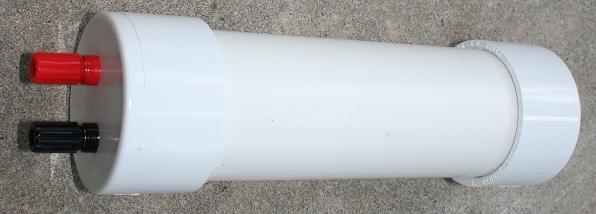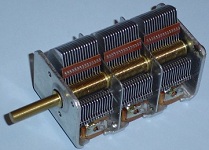|
|
|
|
|
TO ORDER: Call 903-558-1007 |
Small Antennas for 2 KHz to 30 KHz

VLF Band antenna offers high sensitivity and narrow bandwidth.
Directional to help reduce interference when 2 stations from different directions are on the same channel.
Ideal for long range lightning detection applications at 10 KHz - 30 KHz.
For use in
Weather-proof plastic case.
Binding post connections.
Monster-size 6.75 inch long x 1.02 inch diameter ferrite rod core for maximum reception.
Part Number: 6VLF10K30KBC is a Very Low Frequency antenna for 10 KHz - 30 KHz range, and can be user tuned with external variable capacitor user supplies. .
If you chart plot any distant steady beacon in this band you will see a very sudden sharp drop near sunrise, as the sunlight first hits the ionosphere. This band is less sensitive to ionosphere changes, but it can still be used for various types of research.
Signals at 10 KHz to 30 KHz can circle the globe, and super range cloud-to-ground lightning detection is possible in this range.
Specification: (+/- 10 %): 1000 pF tunes @ 21 KHz
Tuning Data: 0.01 uF tunes @ 10 KHz, 5000 pF tunes @ 14 KHz, 1400 pF tunes @ 18 KHz, 1000 pF tunes @ 21 KHz, 400 pF tunes @ 30 KHz.
NOTE: Antennas are 9 inches long.
NOTE: These antennas are bi-directional having a 'figure 8' pattern.
VLF Band antenna offers high sensitivity and very narrow bandwidth.
Directional to help reduce interference when 2 stations from different directions are on the same channel.
Ideal for lightning detection applications at 3 KHz - 17 KHz.
For use in Weather-proof plastic case.
Binding post connections.
Monster-size 6.75 inch long x 1.02 inch inch diameter ferrite rod core for maximum reception.
Part Number: 6VLF3K17KBC is a Very Low Frequency antenna for 3 KHz - 17 KHz range, and can be user tuned with external variable capacitor user supplies.
Signals at 9 KHz to 17 KHz can circle the globe, and super range cloud-to-ground lightning detection is possible in this range.
Specification: (+/- 10 %): 1000 pF tunes @ 11.5 KHz
NOTE: Antennas are 9 inches long.
NOTE: These antennas are bi-directional having a 'figure 8' pattern.
VLF Band antenna offers high sensitivity and very narrow bandwidth.
Directional to help reduce interference.
For use in Weather-proof plastic case.
Binding post connections.
Monster-size 6.75 inch long x 1.02 inch inch diameter ferrite rod core for maximum reception.
Part Number: 6VLF2K7KBC is a Very Low Frequency antenna for 2 KHz - 7 KHz range, and can be user tuned with external variable capacitor user supplies.
Specification: (+/- 10 %): 1000 pF tunes @ 7 KHz
NOTE: Antennas are 9 inches long.
NOTE: These antennas are bi-directional having a 'figure 8' pattern.
Antennas for Short Wave 1.7 MHz - 4 MHz
Lightning Detection: Using the antennas for lightning detection and geophysical research.
The antennas detect the magnetic field part of the radio wave for lightning detection so no other wire antenna is needed. The antennas are directional (bi-directional) so aim antenna for best reception.
Lightning Detection Band A is useful 24 hours a day. Global range possible. Lightning's power output is centered in this band allowing easy detection.
Lightning Detection Band B is useful 24 hours a day. Extreme range possible. High lightning power in this band.
Lightning Detection Band C is useful 24 hours a day. Long range possible. Range increases greatly at night.
Lightning Detection Band D opens at night for very long range detections. Only short range in daytime.
Lightning Detection Band E opens at night for very long range detections. Only short range in daytime. May have power line harmonic hum interference in this band.
Lightning Detection Band F is useful only for detecting local cloud to ground strikes. May have power line hum noise in this band.
Lightning Detection 'A' band properties: The 'A' band at 10 KHz to 15 KHz allows global cloud to ground lightning strikes to be monitored. Propagation is strong day and night for easy very long distance reception. Signals at 10 - 15 KHz can at times circle the globe, coming back to the point of origin as an "echo". No man-made transmissions in this band in the USA. Constant crackling of global lightning static can be heard in this band.
Lightning Detection 'B' band properties: The 'B' band at 7 KHz to 10 KHz allows global cloud to ground lightning strikes to be monitored. The range is greater toward the top end (10 KHz) of the band. Lower range toward the bottom. Slightly better range at night time. No man made signals in this band. Constant crackling of static can be heard in this band. No man made signals in this band.
Lightning Detection 'C' band properties: The 'C' band at 5 KHz to 7 KHz allows hemispheric lightning ground strikes to be monitored. The range is greater at night time than daytime. Static crackling is constantly heard in this band, and it increases greatly at night time as the band opens due to dissipating ionospheric "D" layer for very long range reception. No man made signals in this band.
Lightning Detection 'D' band properties: The 'D' band at 3 KHz to 5 KHz allows hemispheric lightning ground strikes to be monitored at only night time. Range is markedly shorter during the day time, less than 75 miles. Very long range after local midnight when ionosphere "D" layer is faded. The larger strikes are heard here. Natural radio wave emissions and Whistlers (an ionospheric dispersion effect, which causes a very distant lightning strike to sound like a sliding whistle tone instead of the usual static sound) are heard in this band. Whistlers are centered around 3 KHz, but also can be lower or higher in frequency. Geomagnetic storms can cause natural radio wave emissions in this band and in bands lower in frequency. No man made signals in this band.
Lightning Detection 'E' band properties: The 'E' band at 2 KHz to 3 KHz allows long distance lightning ground strikes to be monitored at night time, especially after midnight. Range up to 300 miles night time. Only the larger strikes are detected here. Range is markedly shorter during the daytime, less than 50 miles. No man made signals in this band, except for power line hum harmonics.
Lightning Detection 'F' band properties: The 'F' band at 1 KHz to 2 KHz allows local lightning ground strikes to be monitored as well as signals from geomagnetic storms. Range (for lightning detection) is markedly shorter during the day time, less than 30 miles. The band opens after midnight local time for range up to 300 miles (above 1.7 KHz) for the stronger cloud-to-ground strikes. Whistlers and geomagnetic storm noise (dawn chorus and hiss noise) is heard in the lower half of this band. The Earth - Ionosphere waveguide effect does not support electromagnetic waves of a frequency lower than approximately 1.7 KHz. Range of less than 30 miles will be obtained below this frequency. A sharp contrast (at night) can be heard in the static level at 2 KHz and the static level below 1.5 KHz due to this effect. No man made signals in this band except for powerline harmonic hum. Whistlers extend down to this band. Dawn chorus (a natural radio wave emission that occurs just after dawn, especially during geomagnetic storms) is heard in this band. Dawn chorus range is from 700 Hz to 1.4 KHz.
Lightning Detection 'G' band properties: The 'G' band at 500 Hz to 1 KHz allows local lightning ground strikes to be monitored. Range is less than 30 miles. Whistlers extend down to this band, becoming drawn out and slow sounding. Dawn chorus extends down to 700 Hz and up to 1400 Hz this band. Hiss can be heard in this band. Propagation mode is solely through the ground, water, or along earth's magnetic field lines for non-lightning signals originating more than 30 miles away.
Other Lightning Detection Bands:
Other bands can be used for lightning detection. These bands may have broadcasts or communications and are not used exclusive for lightning detection. Rotate the antenna to completely null any station.
38 KHz - 56 KHz This band allows good long range detection day or night. Better range at night. Time signal beacons and utility stations may be in this band. Powerful static from storms up to 300 miles away.
59 KHz - 61 KHz This band allows good long range detection day or night. Much better range at night. Time signal beacons and utility stations may be in this band. WWVB at 60 KHz heard in this band, aim end of antenna toward this station (located in Colorado, USA), to null it out completely for reception. Powerful lightning static in this band from storms up to 300 miles away.
90 KHz - 110 KHz This band allows good reception of lightning static, storms emit a very high amount of power in this range. The LORAN-C navigation system has been dismantled leaving this range generally clear. Other stations may exist in this range. Rotate antenna to null out completely. Range better at night than in day.
Part # Frequency Price
6VLF10K30KBC 10 KHz - 30 KHz $ 125.00 
Optional variable tuning capacitor for this antenna

Part # Frequency Price
6VLF3K17KBC 3 KHz - 17 KHz $ 125.00 
Optional variable tuning capacitor for this antenna

Part # Frequency Price
6VLF2K7KBC 2 KHz - 7 KHz $ 130.00 
Optional variable tuning capacitor for this antenna
Antennas for AM Broadcast Band 530 KHz - 1710 KHz
Antennas for Long Wave and 30 KHz - 530 KHz
Antennas for Very Low Frequency 3 KHz - 30 KHz
Antennas for Ultra Low Frequency 300 Hz - 3 KHz
Antennas for Super Low Frequency 30 Hz - 300 Hz
Antennas for Extremely Low Frequency 0.03 Hz - 30 Hz